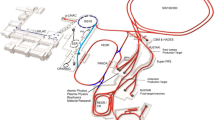Abstract
The PANDA experiment is one of the major projects in preparation at the upcoming Facility for Antiproton and Ion Research (FAIR) in Darmstadt/Germany. A multipurpose high energy physics detector is currently under construction and will be operated at the High Energy Storage Ring (HESR) of FAIR. The physics program includes hadron spectroscopy, search for charm and strangeness in nuclei, hypernuclear physics, nucleon structure and other QCD topics. In this report, some important aspects of the planned physics program of the PANDA experiment are described.
Similar content being viewed by others
Explore related subjects
Discover the latest articles, news and stories from top researchers in related subjects.Avoid common mistakes on your manuscript.
1 INTRODUCTION
High intensity antiproton beams with momenta between 1.5 and 15 GeV/c will be available at FAIR, currently under construction in Darmstadt, Germany. The annihilation processes induced by the antiproton beams of FAIR will be investigated by the PANDA experiment [1] using fixed proton or nuclear targets. The PANDA detector is characterized by almost \(4\pi\) acceptance, a high resolution and tracking capability, and an efficient neutral and charged particle identification in a high production rate environment. The full setup of FAIR is designed to provide a luminosity up to \(2\times 10^{32}\) cm\({}^{-2}\)s\({}^{-1}\). The opportunities offered by the antiproton beam will be exploited by the PANDA experiment to perform precise and unique measurements in four main pillars: charm and exotics, strangeness physics, nucleon structure and hadrons in nuclei. These opportunities are manifested by the large production cross sections of hadronic final states, the wide range of the center-of-mass energies covering the light, strange and the charm quark sectors, and the likely abundant production of the exotic gluonic states.
PANDA Phase One results from Monte Carlo simulations [2]: (a) expected total precisions on the determination of the proton form factor ratio (\(|G_{E}|/|G_{M}|\)), (b) average polarization of the \(\Lambda/\bar{\Lambda}\), (c) sensitivity to the Breit–Wigner width for the \(\chi_{c1}(3872)\) state.
2 PANDA PHASE ONE PROGRAM
The PANDA experiment will follow a phased approach related to the construction of the detector and to the available luminosity that will be delivered by the HESR of FAIR. After the installation of the major detector components, PANDA Phase One will start with a luminosity up to \(1\times\) \(10^{31}\) cm\({}^{-2}\)s\({}^{-1}\). During this phase of measurements, the physics processes of high production cross section and low final state multiplicity will be mainly addressed. Feasibility studies of measuring these processes at PANDA have been performed using Monte Carlo simulations within the PANDARoot software framework. The PANDA Phase One program is described in [2]. In the following, some of the results which are expected to be achieved during this phase will be presented.
Charm and exotics—\(\chi_{c1}(3872)\) state: in \(\bar{p}p\) annihilation, mesonic-like states can be studied in formation mode without severe constraints on spin and parity combinations. In this case, the line shape of the resonance state can be determined using the resonance energy scan. The precision of the measurements using this technique is given by the beam resolution which is at the order of 50 keV at PANDA. The capability of PANDA to perform resonance energy scans has been investigated using the process \(\bar{p}p\to\chi_{c1}(3872)\to J/\Psi\rho^{0}\). The \(\chi_{c1}(3872)\) state is characterized by a small natural width that demands a precision line shape measurement with a high beam momentum resolution. The sensitivity of PANDA to the absolute Breit–Wigner width (\(\Gamma_{0}\)) is shown in Fig. 1c. For values of \(\Gamma_{0}\) larger than 110 keV a 3\(\sigma\) relative error better than 33 \(\%\) can be achieved.
Strangeness physics—\(\bar{p}p\to\bar{\Lambda}\Lambda\) : hyperons and antihyperons can be produced at PANDA in two-body reactions \(\bar{p}p\to\bar{h}_{1}h_{2}\). The center-of-mass energy range of PANDA, between 2.2 and 5.5 GeV, covers the kinematical threshold for various single, double and triple strangeness hyperons. Taking into account the large cross section of the hyperon pair production in \(\bar{p}p\) annihilation and the large acceptance of the PANDA detector, studies of hyperpon production, hyperon spectroscopy and hyperon decays are planned. In hyperon production studies, the measurement of spin observables, e.g., polarization and spin correlations, is important to understand the production mechanism of hyperons. Figure 1b shows the good capability of PANDA to reconstruct the polarization distribution of \(\Lambda\)-hyperon after a few hours of data taking during Phase One.
Nucleon structure—electromagnetic form factors of the proton: an important part of the PANDA measurements will be dedicated to the electromagnetic processes for the investigation of the nucleon structure. In Phase One, it is planned to measure the proton electromagnetic form factors in the time-like region using the annihilation processes \(\bar{p}p\to e^{+}e^{-}\) and \(\bar{p}p\to\mu^{+}\mu^{-}\). Figure 1a shows the expected precisions on the determination of the proton form factor ratio (\(|G_{E}|/|G_{M}|\)) at PANDA Phase One. The results correspond to an integrated luminosity of 0.1 fb\({}^{-1}\) per beam momentum setting and show that PANDA will improve the precision of the proton form factor measurements for momentum transfer squared \(q^{2}>5\) (GeV/c)\({}^{2}\). The proton form factors can be measured with the muon channel for the first time. In the next stages of PANDA, these measurements can be extended up to higher values of \(q^{2}\) and with an improved accuracy.
3 SUMMARY
The PANDA experiment at FAIR will carry out precision studies of the strong interaction at intermediate energies. A wide experimental program covering different pillars in hadron and nuclear physics is foreseen. A part of the program has been described in this report.
4 CONFLICT OF INTEREST
The author declares that he has no conflicts of interest.
REFERENCES
M. Lutz et al. (PANDA Collab.), ‘‘PANDA physics performance report,’’ arXiv: 0903.3905 [hep-ex] (2009).
G. Barucca et al. (PANDA Collab.), ‘‘PANDA phase one,’’ Eur. Phys. J. A 57, 184 (2021).
Author information
Authors and Affiliations
Consortia
Corresponding author
Ethics declarations
The author declares that he has no conflicts of interest.
About this article
Cite this article
Dbeyssi, A., PANDA Collaboration. The PANDA Experiment at FAIR. Moscow Univ. Phys. 77, 193–194 (2022). https://doi.org/10.3103/S0027134922020266
Received:
Published:
Issue Date:
DOI: https://doi.org/10.3103/S0027134922020266





